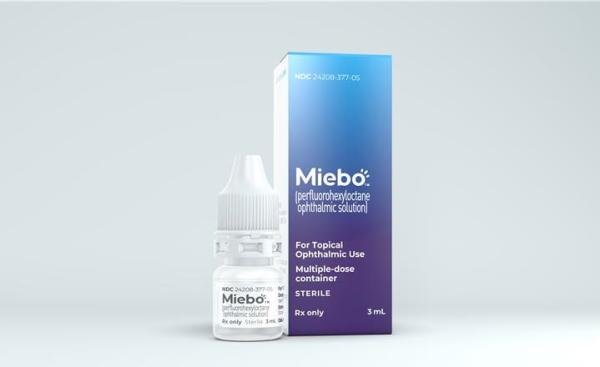Perfluorohexyloctane (Monograph)
Brand name: Miebo
Drug class: EENT Drugs, Miscellaneous
Introduction
Perfluorohexyloctane is an anhydrous semifluorinated alkane.
Uses for Perfluorohexyloctane
Perfluorohexyloctane has the following uses:
Perfluorohexyloctane ophthalmic solution is indicated for treatment of the signs and symptoms of dry eye disease.
Efficacy and safety of perfluorohexyloctane have been established in 2 randomized, multicenter, double-masked, saline-controlled phase 3 studies (GOBI and MOJAVE). In these studies, perfluorohexyloctane opththalmic solution (administered 4 times daily) significantly reduced total corneal fluorescin staining (tCFS) compared with saline in adults with dry eye disease associated with meibomian gland dysfunction. Perfluorohexyloctane also had a significant effect on symptoms of dry eye disease as assessed by patient-rated eye dryness scores.
Perfluorohexyloctane Dosage and Administration
General
Perfluorohexyloctane is available in the following dosage form(s) and strength(s):
Ophthalmic solution containing 100% perfluorohexyloctane; commercially available in multiple-dose bottles.
Dosage
It is essential that the manufacturer's labeling be consulted for more detailed information on dosage and administration of this drug. Dosage summary:
Adults
Dosage and Administration
Apply topically to the eye as an ophthalmic solution.
Instill one drop of perfluorohexyloctane four times daily into each eye.
To administer the drug, remove the cap from the eye drop bottle. Hold the bottle upright and gently squeeze the bottle. While squeezing, turn the bottle upside down and release the pressure (drawing air into the bottle). Keep the bottle upside down, place the bottle above the eye and squeeze it again to release a drop into the eye. Repeat these steps for the second affected eye.
Cautions for Perfluorohexyloctane
Contraindications
-
None.
Warnings/Precautions
Use with Contact Lenses
Perfluorohexyloctane should not be administered while wearing contact lenses. Advise patients that contact lenses should be removed prior to and for at least 30 minutes after administration of perfluorohexyloctane.
Specific Populations
Pregnancy
There are no adequate and well controlled studies with perfluorohexyloctane in pregnant women.
In animal reproduction studies with oral administration of perfluorohexyloctane during the period of organogenesis, no adverse maternal or developmental effects were observed in rats at doses up to 162 times the recommended human ophthalmic dose (RHOD). Maternal toxicity, miscarriages, and reduced fetal weights were observed in rabbits at all doses tested, with the lowest dose as 41 times the RHOD.
All pregnancies have a risk of birth defect, loss, or other adverse outcomes. In the US general population, the estimated background risk of major birth defects is 2 to 4%, and of miscarriage is 15 to 20%, of clinically recognized pregnancies.
Lactation
There are no data on the presence of perfluorohexyloctane in human milk, the effects on the breastfed infant, or the effects on milk production. The lack of clinical data during lactation precludes a clear determination of the risk of perfluorohexyloctane to an infant during lactation; however, the developmental and health benefits of breastfeeding should be considered along with the mother’s clinical need for perfluorohexyloctane.
Pediatric Use
The safety and effectiveness of perfluorohexyloctane in pediatric patients <18 years have not been established.
Geriatric Use
No overall differences in safety and effectiveness have been observed between elderly and younger patients.
Common Adverse Effects
Most common ocular adverse reaction was blurred vision. Blurred vision was reported in less than 4% of individuals.
Drug Interactions
Specific Drugs
It is essential that the manufacturer's labeling be consulted for more detailed information on interactions with this drug, including possible dosage adjustments. Interaction highlights:
Please see product labeling for drug interaction information.
Actions
Mechanism of Action
Perfluorohexyloctane, a semifluorinated alkane, contains 6 perfluorinated carbon atoms and 8 hydrogenated carbon atoms. The exact mechanism of action of perfluorohexyloctane in dry eye disease is not known. Because of its chemical structure, perfluorohexyloctane has amphiphilic properties, and due to its low surface tension, spreads rapidly across the ocular surface. Perfluorohexyloctane is thought to prevent evaporation of the tear film by forming a monolayer at the air-liquid interface.
Advice to Patients
-
Advise patients that contact lenses should be removed prior to and for at least 30 minutes after administration of perfluorohexyloctane.
-
Advise patients to instill one drop of perfluorohexyloctane four times daily into each eye as depicted in the manufacturer's Administration Instructions.
Additional Information
AHFSfirstRelease™. For additional information until a more detailed monograph is developed and published, the manufacturer's labeling should be consulted. It is essential that the manufacturer's labeling be consulted for more detailed information on usual uses, dosage and administration, cautions, precautions, contraindications, potential drug interactions, laboratory test interferences, and acute toxicity.
Preparations
Excipients in commercially available drug preparations may have clinically important effects in some individuals; consult specific product labeling for details.
Please refer to the ASHP Drug Shortages Resource Center for information on shortages of one or more of these preparations.
|
Routes |
Dosage Forms |
Strengths |
Brand Names |
Manufacturer |
|---|---|---|---|---|
|
Ophthalmic |
Solution |
1.338 g of perfluorohexyloctane per mL |
Miebo (available in multiple-dose bottles; preservative-free) |
Bausch & Lomb |
AHFS DI Essentials™. © Copyright 2024, Selected Revisions June 22, 2023. American Society of Health-System Pharmacists, Inc., 4500 East-West Highway, Suite 900, Bethesda, Maryland 20814.
Reload page with references included
More about perfluorohexyloctane ophthalmic
- Compare alternatives
- Reviews (15)
- Side effects
- Dosage information
- During pregnancy
- Drug class: ophthalmic anti-inflammatory agents
- En español

